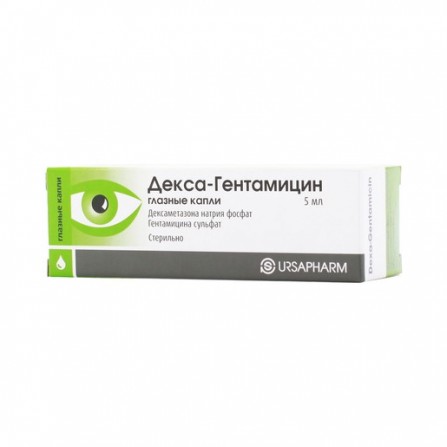Dexa-gentamicin eye drops 5ml
Condition: New product
1000 Items
Rating:
Be the first to write a review!

More info
Active ingredients
Gentamicin + Dexamethasone
Release form
Drops
Composition
1 ml: dexamethasone sodium phosphate 1 mg, gentamicin sulfate 5 mg, which corresponds to the content of gentamicin 3 mg. Excipients: benzalkonium chloride (preservative) - 0.05 mg, potassium hydrogen phosphate - 1.88 mg, potassium dihydrogen phosphate - 5.86 mg, sodium chloride - 5 mg, water d / and - up to 1 ml.
Pharmacological effect
The combined drug for local use in ophthalmology. It has anti-allergic, anti-inflammatory and antibacterial effects. Dexamethasone - GCS, has anti-allergic and pronounced anti-inflammatory effects. The index of its relative anti-inflammatory activity is 30. Gentamicin is an antibiotic of the group of aminoglycosides, characterized by a wide spectrum of action. It is active against most gram-positive and gram-negative microorganisms, incl. Pseudomonas aeruginosa, Escherichia coli, Klebsiella spp., Salmonella spp., Proteus spp., Serratia spp. Moderately active against Staphylococcus spp.
Pharmacokinetics
When applied topically, dexamethasone penetrates well into the corneal epithelium and conjunctiva; at the same time, therapeutic concentrations are achieved in the aqueous humor; when inflammation or damage to the mucous membrane, the rate of penetration increases. Gentamicin sulfate, when applied topically, is found in therapeutic concentrations in the stroma of the cornea, in the anterior chamber moisture, the vitreous body for 6 hours. Gentamicin sulfate does not penetrate into the systemic circulation through the intact corneal epithelium
Indications
Infections of the anterior segment of the eye caused by gentamicin-sensitive microflora (conjunctivitis, keratitis, blepharitis, barley); Allergic processes of the anterior segment of the eye, accompanied by bacterial infection; Prevention and treatment of inflammatory events in the postoperative period (after removal of cataract and antiglaucoma operations)
Contraindications
Herpes simplex and Varicella zoster viruses (tree keratitis); Viral diseases of the cornea and conjunctiva (including chickenpox); Fungal diseases of the eye; Mycobacterial infections of the eye; Acute purulent diseases of the eye with corneal epithelium; Epitheliopathy of the cornea; Traumas and ulcerscorneal lesions; Increased intraocular pressure; I trimester of pregnancy; Children and adolescents under 18 years of age (due to lack of data on efficacy and safety); Wearing contact lenses; Increased sensitivity to components of the drug. While using the drug, it is not recommended to use contact lenses.
Use during pregnancy and lactation
Adequate and strictly controlled clinical studies of the safety of the use of the drug Dexa-gentamicin during pregnancy and lactation has not been conducted. In the II and III trimesters of pregnancy and during breastfeeding, the drug can be used in the case when the intended benefit of therapy for the mother outweighs the potential risk to the fetus or child. Contraindicated in the first trimester of pregnancy.
Dosage and administration
Dexa-gentamicin eye drops are instilled into the conjunctival sac 1-2 drops 4-6 times a day. A strip of 1 cm long 1 cm is placed in the conjunctival sac 2-3 times a day. During the application of an eye ointment, contact of the tube with the surface of the skin or conjunctiva should be avoided. Dexa-gentamicin treatment usually does not exceed 2-3 weeks. The duration of therapy is determined by the effectiveness of the drug, severity of symptoms and the likelihood of side effects. When several ophthalmic drugs are used simultaneously, it is recommended to put Dexa-gentamicin in the form of an ophthalmic ointment no earlier than 15 minutes after using eye drops.
Side effects
Rarely: allergic reactions, burning sensation in the eye after using the drug. Possible: contact dermatitis, herpetic keratitis, corneal perforation in the presence of keratitis, fungal infection, increased severity of bacterial infection of the cornea, ptosis, mydriasis. Application after corneal injuries can lead to slower healing. With prolonged use - the development of secondary glaucoma, steroid cataracts.
Overdose
When using the drug Dexa-gentamicin overdose is unlikely.
Interaction with other drugs
When combined with atropine, other cholinergic drugs, drugs causing mydriasis, it is possible to increase intraocular pressure. When applied locally, gentamicin is incompatible with amphotericin B, heparin, sulfadiazine, cephalothin and cloxacillin. Topical use of these drugs together with gentamicin can lead to deposition of precipitates in the conjunctival cavity.
special instructions
With a duration of use of the drug for more than 2 weeks, as well as in patients with a history of glaucoma, it is recommended to regularly monitor intraocular pressure. If the use of contact lenses is necessary, they should be removed before using Dexa-gentamicin in the form of eye drops and installed again no earlier than 20 min. The patient should be informed that in the event of side effects, stop treatment immediately and consult an ophthalmologist. Use as a pediatrician Ido present data from clinical studies of safety and efficacy of the drug Dexa-Gentamicin have no children. Drug use in pediatrics is possible if the expected therapeutic effect outweighs the potential risk of adverse reactions. Impact on the ability to drive vehicles and control mechanisms Immediately after using the drug Dexa-gentamicin, a short-term visual acuity may occur, leading to a slowdown of psychomotor reactions. Therefore, it is not recommended to use the drug immediately before working with the mechanisms and driving vehicles. Within 30 minutes after instillation, it is necessary to refrain from activities that require increased attention.




